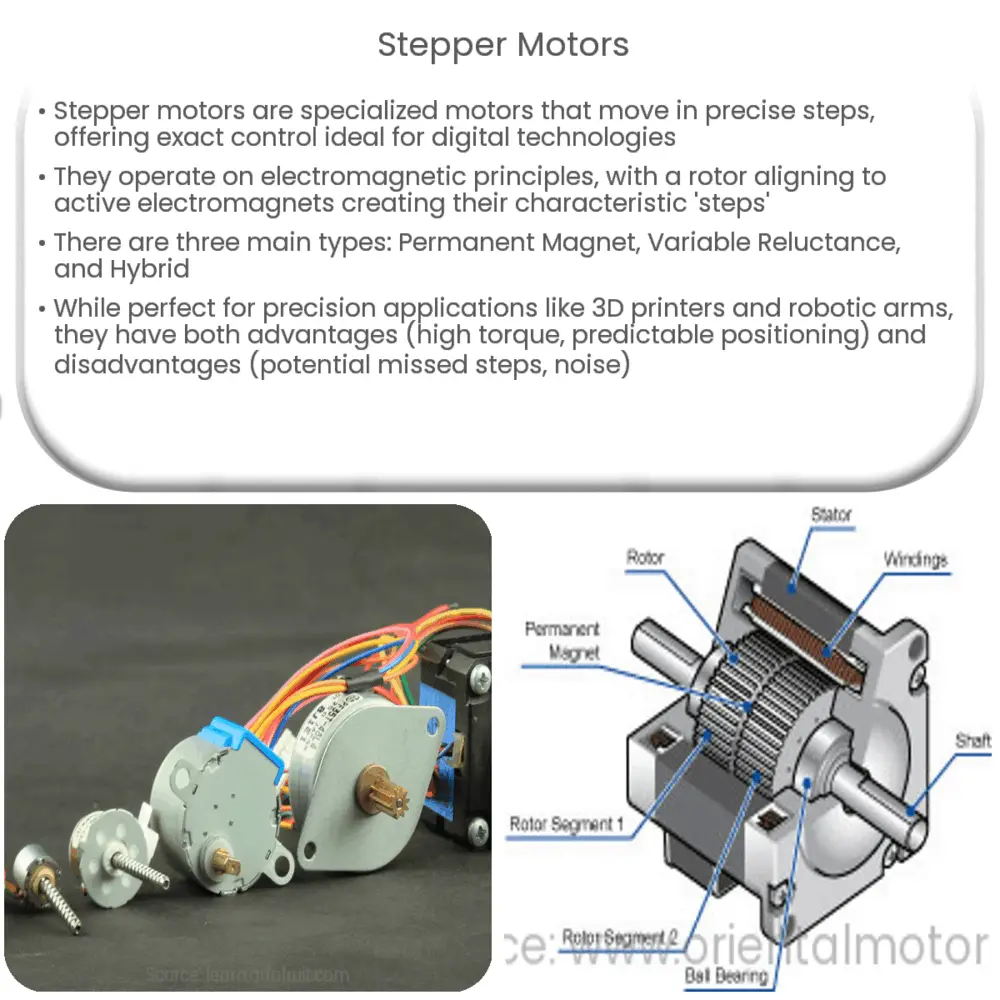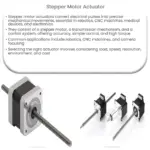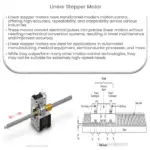Explore the world of stepper motors, their working principle, types, applications, control mechanisms, advantages, and disadvantages.

Introduction to Stepper Motors
Stepper motors hold a key place in the realm of automation and robotics. They are specialized types of motors that move in discrete steps, providing precise control over motion which makes them perfect for many digital technologies. Unlike standard motors, they don’t rotate continuously, rather they take precise “steps”, hence the name.
Working Principle
The operation of stepper motors relies on basic electromagnetic principles. Each motor houses a central gear-shaped piece of iron, known as the rotor, surrounded by several electromagnets, collectively referred to as the stator.
-
At the most basic level, the motor works by turning the electromagnets on and off in a particular sequence. This sequence results in the creation of a magnetic field which pulls the rotor in the direction of the active electromagnet.
-
As the sequence changes, the direction of the magnetic field changes as well, causing the rotor to continually align itself with the active electromagnet. This constant realignment results in the ‘steps’ that characterize the movement of stepper motors.
Types of Stepper Motors
Stepper motors can be classified into three main types based on the design of the rotor.
-
Permanent Magnet Stepper Motors: These types of stepper motors use a permanent magnet in the rotor and operate based on the attraction and repulsion between the rotor and stator.
-
Variable Reluctance Stepper Motors: These do not have a permanent magnet. Instead, they use a plain iron rotor. The steps are achieved by minimizing magnetic reluctance.
-
Hybrid Stepper Motors: These motors are a blend of both permanent magnet and variable reluctance types. They offer better performance and higher step resolution.
Stepper Motors in Applications
Stepper motors find their use in a wide variety of applications that require precision, repeatability, and high torque at low speeds. These include:
-
3D printers and CNC machines where they move the print head and cutting tool with extreme precision.
-
Robotic arms in assembly lines where accuracy and reliability are crucial.
Stepper motors have a significant role in modern technology, driving innovation and providing an essential tool in the realm of precision control. In the next part, we will explore more on their control mechanisms, advantages, and disadvantages.
Control Mechanisms
Stepper motors are typically controlled using digital pulses rather than a continuous flow of voltage. This feature allows us to interface stepper motors easily with digital systems like microcontrollers and computers.
-
Full Step Drive: This method energizes two phases at a time, leading to maximum torque but higher energy consumption. Each step in this mode corresponds to the motor’s basic step angle.
-
Half Step Drive: This method alternates between energizing one phase and two phases at a time. This effectively halves the step size, providing increased resolution at the cost of slightly reduced torque.
-
Microstepping: This method uses varying levels of current in the phases to create even smaller steps, further increasing the resolution.
Advantages and Disadvantages
Like all technologies, stepper motors come with their own set of advantages and disadvantages.
Advantages
-
High torque at low speeds, making them ideal for precision applications.
-
Excellent response to starting, stopping, and reversing.
-
Predictable positioning since they move in discrete steps.
Disadvantages
-
Lower efficiency as the motor draws current regardless of load.
-
Potential for missed steps due to high-speed performance issues or mechanical resonance.
-
Can be noisy due to vibrations from stepping action.
Conclusion
Stepper motors play a vital role in many fields of technology, including robotics, CNC machines, 3D printers, and more, due to their high precision, repeatability, and excellent low-speed torque characteristics. Despite some drawbacks, such as the risk of missed steps and lower efficiency, their advantages make them indispensable in the current era of automation and precision control. As technology evolves, we expect to see improvements in the performance of stepper motors, expanding their applications and making them even more integral to our technologically-driven world.




